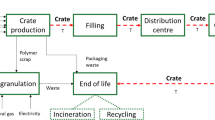Abstract
Goal, Scope and Background.
The object of the study is the Italian system of plastic packaging waste recycling, active until 2001, that collected and mechanically recycled the post-consumer PE and PET liquid containers. The phases of collection, compaction, sorting, reprocessing and refuse disposal were individually analysed and quantified in terms of energy and material consumptions as well as of emissions in the environment. The work is the result of a joint research project with the Italian Consortium for Packaging (CONAI), carried out in co-operation with the main Italian companies active in the field. The main aim was the quantification of the real advantage of plastic container recycling and the definition of criteria, at the same time environmentally compatible and economically sustainable, for their management.
Main Features
For each of the unit processes, and in order to increase the data quality, all the data of interest were collected during technical visits to several selected plants active in Italy or deduced by official documents and certificate declarations of the same companies. To allow comparison of resource consumption and environmental pollution from different management scenarios producing different products, thebasket of products method was applied.
Results
The results indicates that the production of 1 kg of flakes of recycled PET requires a total amount of gross energy that is in the range of between 42 and 55 MJ, depending on whether the process wastes (mainly coming from sorting and reprocessing activities) were sent or not to the energy recovery. The same quantity of virgin PET requires more than 77 MJ. The energetic (and then environmental) saving is so remarkable, even for PE, being 40–49 MJ for the recycled polymer and about 80 MJ that for the virgin polyolefin. The calculations were made with the reasonable assumption that the final utilisation can use the virgin or the recycled polymer without any difference.
Conclusions and Outlook
The analysis defined and verified a suitable tool in the field, based on objective data, for comparing different coherent scenarios of waste management politics. This allows one to propose the extension of the tool under different collection schemes, as well as for different systems of packaging recycling. As an immediate consequence of the success of the present study, the joint-research programme with CONAI has been extended for another three years. The focus will be the Italian system for paper and paperboard recycling and that for all plastic packagings. In parallel, a different study has been scheduled with reference to the integrated solid waste management of the Regione Campania, the largest and most populated area in the South of Italy.
Similar content being viewed by others
Explore related subjects
Discover the latest articles, news and stories from top researchers in related subjects.References
Ademe and Eco-Emballages (2001): Déchets ménagers: leviers d’améliorations des impacts environnementaux. Ademe/Eco-Emballages co-editors, Levallois-Perret, France
Arena U, Mastellone ML, Perugini F (2001): Final Report of CONAI-DSA Joint Res. Prog., also summarized in PLAST (2002) 4, 97–99
Asante-Duah DK (1998): Risk Assessment in Environmental Management. J. Wiley & Sons Ltd, New York
Beccali G, Yellula M, Ristretta M (2001): Managing Municipal Solid Waste. Int J LCA 6 (4) 243–249
Bez J, Heyde M, Goldhan G (1998): Waste Treatment in Product Specific Life Cycle Inventories. Int J LCA 3 (2) 100–105
Brandrup J, Bittner M, Michaeli W, Menges G (1996): Recycling and Recovery of Plastics. Hanser Publ., New York
Boustead I (1996): Theory and Definitions in Ecobalances. In: Brandrup et al. (eds) Recycling and Recovery of Plastics. Hanser Publ., New York, pp. 73–93
Clift R, Doig A, Finnveden G (2000): The Application of Life Cycle Assessment to Integrated Waste Management. Part 1 — Methodology. Trans IchemE 78 (B) 279–287
Ebert F, Fleischer G, Holley W (1996): Life-Cycle Analysis of Recycling and Recovery of Household Plastics Waste Packaging materials. In: Brandrup et al. (eds) Recycling and Recovery of Plastics. Hanser Publ., New York, pp. 168–192
Finneveden G et al. (1995): Solid Waste Treatment within the Framework of Life Cycle Assessment. J Cleaner Prod 3 (4) 189–199
Heyde M, Kremer M (1999): Recycling and Recovery of Plastics from Packagings in Domestic Waste. LCA-type Analysis of Different Strategies. LCA Documents Vol. 5, ecomed publishers, Landsberg, Germany
Mastellone ML (1999): Thermal Treatments of Plastic Wastes by means of Fluidized Bed Reactors. PhD Thesis in Chemical Engineering, University ‘Federico II’ of Naples
Mastellone ML, Perugini F, Arena U (2002): Life Cycle Assessment of Mechanical Recycling of Plastic Containers for Liquids. 2nd Int. Conf. on Polymer Modification, Degradation and Stabilisation, ISBN 963-420-723–5, Budapest (Hungary), June 30-July 4
McDougall FR, White P, Franke M, Hindle P (2001): Integrated Solid Waste Management: a Life cycle Inventory. 2nd ed., Blackwell Science
Weitz K, Barlaz M, Ranjithan R, Brill D, Thorneloe S, Ham R (1999): Life Cycle Management of Municipal Solid Waste. Int J LCA 4 (4) 195–201
Author information
Authors and Affiliations
Corresponding authors
Rights and permissions
About this article
Cite this article
Arena, U., Mastellone, M.L. & Perugini, F. Life Cycle assessment of a plastic packaging recycling system. Int J LCA 8, 92–98 (2003). https://doi.org/10.1007/BF02978432
Received:
Accepted:
Issue Date:
DOI: https://doi.org/10.1007/BF02978432




